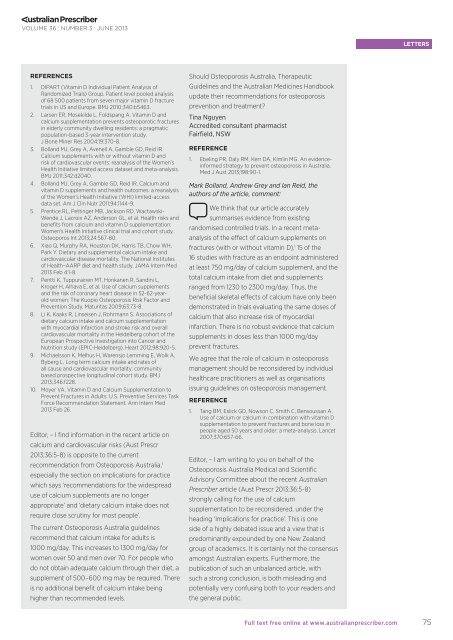download the full PDF issue - Australian Prescriber
download the full PDF issue - Australian Prescriber
download the full PDF issue - Australian Prescriber
Create successful ePaper yourself
Turn your PDF publications into a flip-book with our unique Google optimized e-Paper software.
VOLUME 36 : NUMBER 3 : JUNE 2013<br />
LETTERS<br />
REFERENCES<br />
1. DIPART (Vitamin D Individual Patient Analysis of<br />
Randomized Trials) Group. Patient level pooled analysis<br />
of 68 500 patients from seven major vitamin D fracture<br />
trials in US and Europe. BMJ 2010;340:b5463.<br />
2. Larsen ER, Mosekilde L, Foldspang A. Vitamin D and<br />
calcium supplementation prevents osteoporotic fractures<br />
in elderly community dwelling residents: a pragmatic<br />
population-based 3-year intervention study.<br />
J Bone Miner Res 2004;19:370-8.<br />
3. Bolland MJ, Grey A, Avenell A, Gamble GD, Reid IR.<br />
Calcium supplements with or without vitamin D and<br />
risk of cardiovascular events: reanalysis of <strong>the</strong> Women’s<br />
Health Initiative limited access dataset and meta-analysis.<br />
BMJ 2011;342:d2040.<br />
4. Bolland MJ, Grey A, Gamble GD, Reid IR. Calcium and<br />
vitamin D supplements and health outcomes: a reanalysis<br />
of <strong>the</strong> Women’s Health Initiative (WHI) limited-access<br />
data set. Am J Clin Nutr 2011;94:1144-9.<br />
5. Prentice RL, Pettinger MB, Jackson RD, Wactawski-<br />
Wende J, Lacroix AZ, Anderson GL, et al. Health risks and<br />
benefits from calcium and vitamin D supplementation:<br />
Women’s Health Initiative clinical trial and cohort study.<br />
Osteoporos Int 2013;24:567-80.<br />
6. Xiao Q, Murphy RA, Houston DK, Harris TB, Chow WH,<br />
Park Y. Dietary and supplemental calcium intake and<br />
cardiovascular disease mortality. The National Institutes<br />
of Health–AARP diet and health study. JAMA Intern Med<br />
2013 Feb 4:1-8.<br />
7. Pentti K, Tuppurainen MT, Honkanen R, Sandini L,<br />
Kroger H, Alhava E, et al. Use of calcium supplements<br />
and <strong>the</strong> risk of coronary heart disease in 52-62-yearold<br />
women: The Kuopio Osteoporosis Risk Factor and<br />
Prevention Study. Maturitas 2009;63:73-8.<br />
8. Li K, Kaaks R, Linseisen J, Rohrmann S. Associations of<br />
dietary calcium intake and calcium supplementation<br />
with myocardial infarction and stroke risk and overall<br />
cardiovascular mortality in <strong>the</strong> Heidelberg cohort of <strong>the</strong><br />
European Prospective Investigation into Cancer and<br />
Nutrition study (EPIC-Heidelberg). Heart 2012;98:920-5.<br />
9. Michaelsson K, Melhus H, Warensjo Lemming E, Wolk A,<br />
Byberg L. Long term calcium intake and rates of<br />
all cause and cardiovascular mortality: community<br />
based prospective longitudinal cohort study. BMJ<br />
2013;346:f228.<br />
10. Moyer VA. Vitamin D and Calcium Supplementation to<br />
Prevent Fractures in Adults: U.S. Preventive Services Task<br />
Force Recommendation Statement. Ann Intern Med<br />
2013 Feb 26.<br />
Editor, – I find information in <strong>the</strong> recent article on<br />
calcium and cardiovascular risks (Aust Prescr<br />
2013;36:5-8) is opposite to <strong>the</strong> current<br />
recommendation from Osteoporosis Australia, 1<br />
especially <strong>the</strong> section on implications for practice<br />
which says ‘recommendations for <strong>the</strong> widespread<br />
use of calcium supplements are no longer<br />
appropriate’ and ‘dietary calcium intake does not<br />
require close scrutiny for most people’.<br />
The current Osteoporosis Australia guidelines<br />
recommend that calcium intake for adults is<br />
1000 mg/day. This increases to 1300 mg/day for<br />
women over 50 and men over 70. For people who<br />
do not obtain adequate calcium through <strong>the</strong>ir diet, a<br />
supplement of 500–600 mg may be required. There<br />
is no additional benefit of calcium intake being<br />
higher than recommended levels.<br />
Should Osteoporosis Australia, Therapeutic<br />
Guidelines and <strong>the</strong> <strong>Australian</strong> Medicines Handbook<br />
update <strong>the</strong>ir recommendations for osteoporosis<br />
prevention and treatment<br />
Tina Nguyen<br />
Accredited consultant pharmacist<br />
Fairfield, NSW<br />
REFERENCE<br />
1. Ebeling PR, Daly RM, Kerr DA, Kimlin MG. An evidenceinformed<br />
strategy to prevent osteoporosis in Australia.<br />
Med J Aust 2013;198:90-1.<br />
Mark Bolland, Andrew Grey and Ian Reid, <strong>the</strong><br />
authors of <strong>the</strong> article, comment:<br />
We think that our article accurately<br />
summarises evidence from existing<br />
randomised controlled trials. In a recent metaanalysis<br />
of <strong>the</strong> effect of calcium supplements on<br />
fractures (with or without vitamin D), 1 15 of <strong>the</strong><br />
16 studies with fracture as an endpoint administered<br />
at least 750 mg/day of calcium supplement, and <strong>the</strong><br />
total calcium intake from diet and supplements<br />
ranged from 1230 to 2300 mg/day. Thus, <strong>the</strong><br />
beneficial skeletal effects of calcium have only been<br />
demonstrated in trials evaluating <strong>the</strong> same doses of<br />
calcium that also increase risk of myocardial<br />
infarction. There is no robust evidence that calcium<br />
supplements in doses less than 1000 mg/day<br />
prevent fractures.<br />
We agree that <strong>the</strong> role of calcium in osteoporosis<br />
management should be reconsidered by individual<br />
healthcare practitioners as well as organisations<br />
issuing guidelines on osteoporosis management.<br />
REFERENCE<br />
1. Tang BM, Eslick GD, Nowson C, Smith C, Bensoussan A.<br />
Use of calcium or calcium in combination with vitamin D<br />
supplementation to prevent fractures and bone loss in<br />
people aged 50 years and older: a meta-analysis. Lancet<br />
2007;370:657-66.<br />
Editor, – I am writing to you on behalf of <strong>the</strong><br />
Osteoporosis Australia Medical and Scientific<br />
Advisory Committee about <strong>the</strong> recent <strong>Australian</strong><br />
<strong>Prescriber</strong> article (Aust Prescr 2013;36:5-8)<br />
strongly calling for <strong>the</strong> use of calcium<br />
supplementation to be reconsidered, under <strong>the</strong><br />
heading ‘Implications for practice’. This is one<br />
side of a highly debated <strong>issue</strong> and a view that is<br />
predominantly expounded by one New Zealand<br />
group of academics. It is certainly not <strong>the</strong> consensus<br />
amongst <strong>Australian</strong> experts. Fur<strong>the</strong>rmore, <strong>the</strong><br />
publication of such an unbalanced article, with<br />
such a strong conclusion, is both misleading and<br />
potentially very confusing both to your readers and<br />
<strong>the</strong> general public.<br />
Full text free online at www.australianprescriber.com<br />
75
















